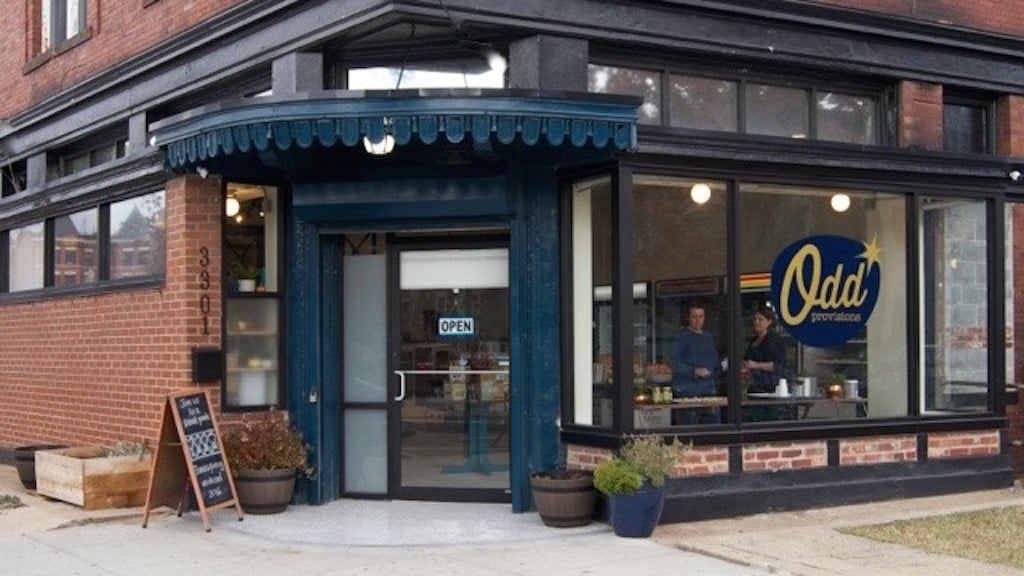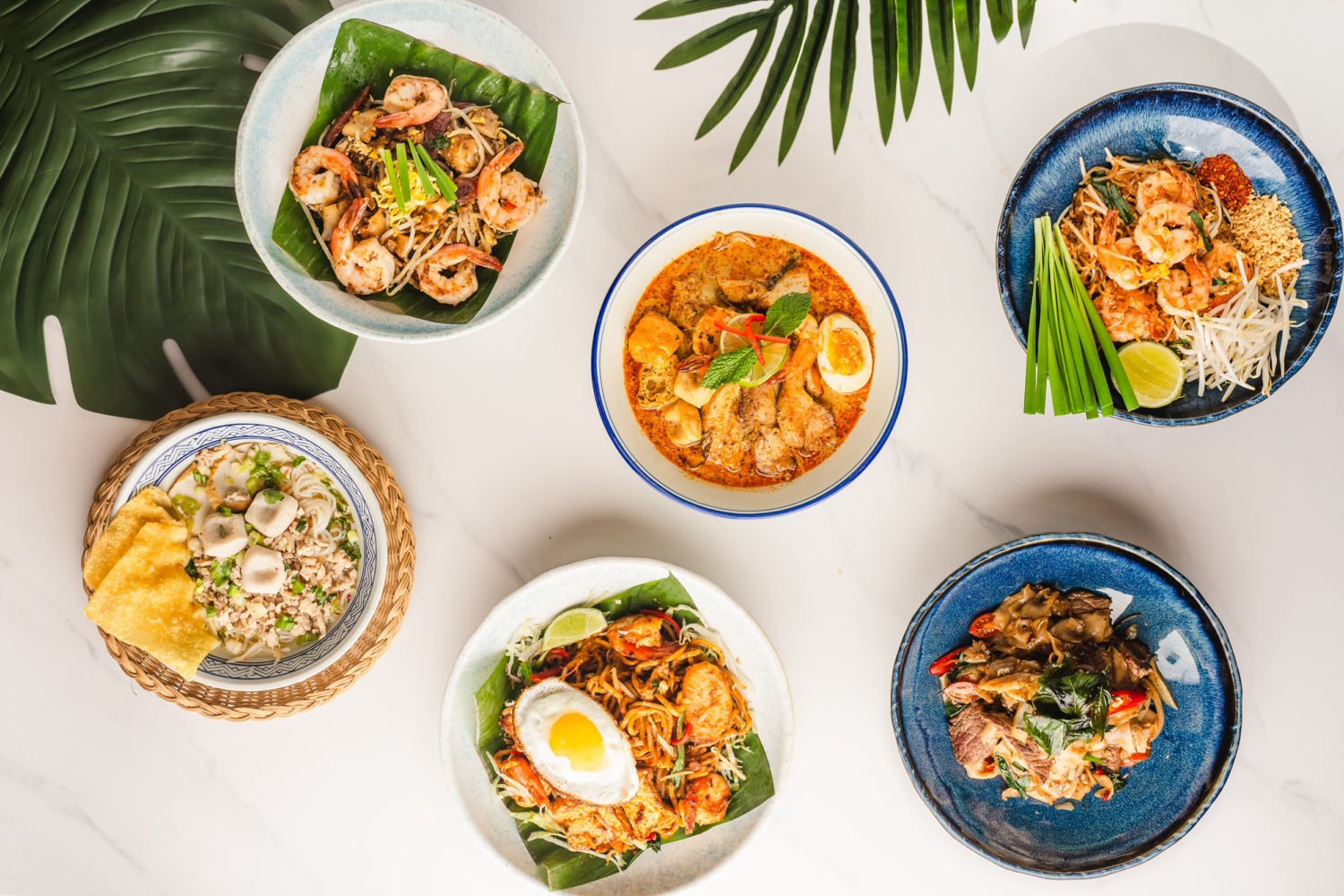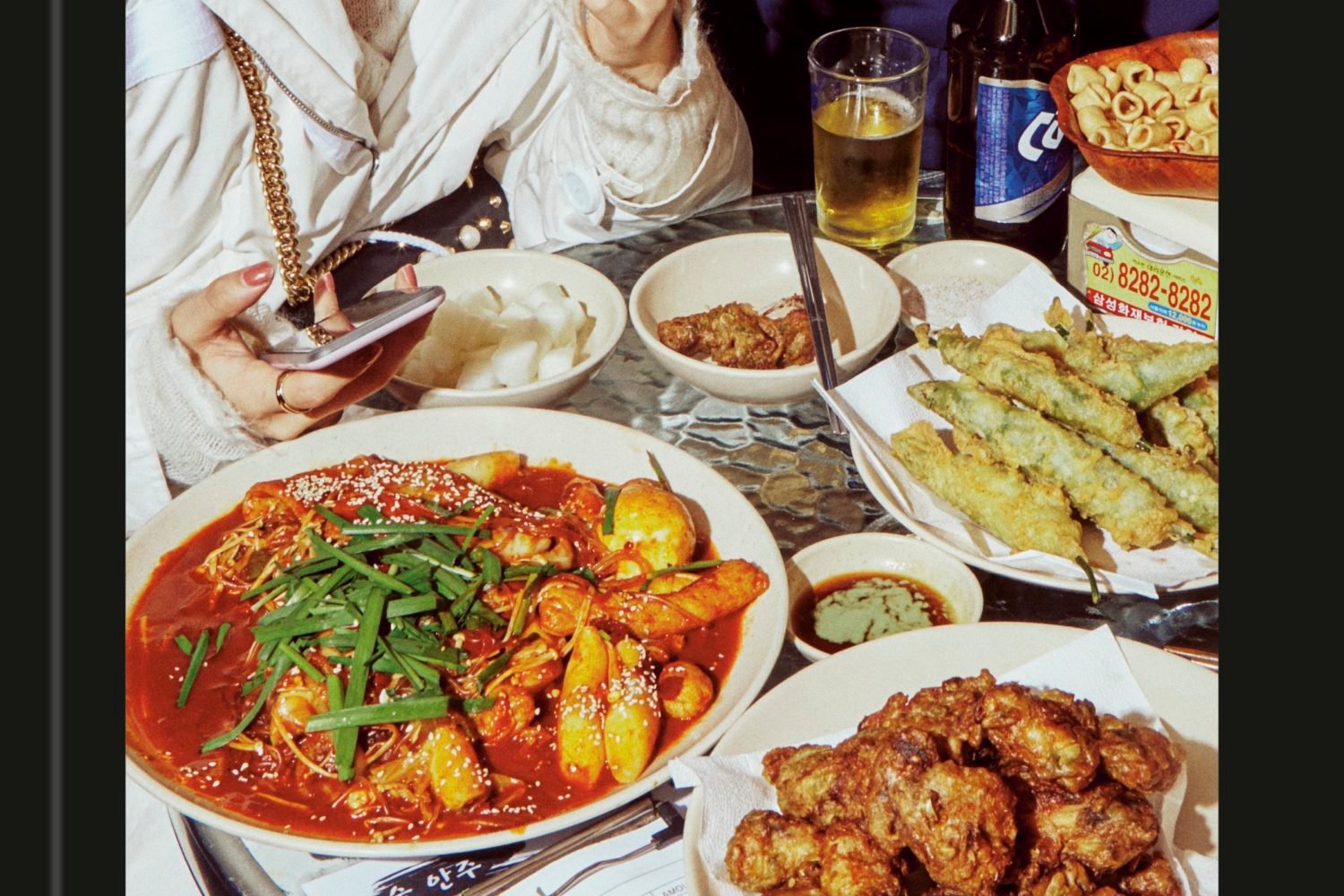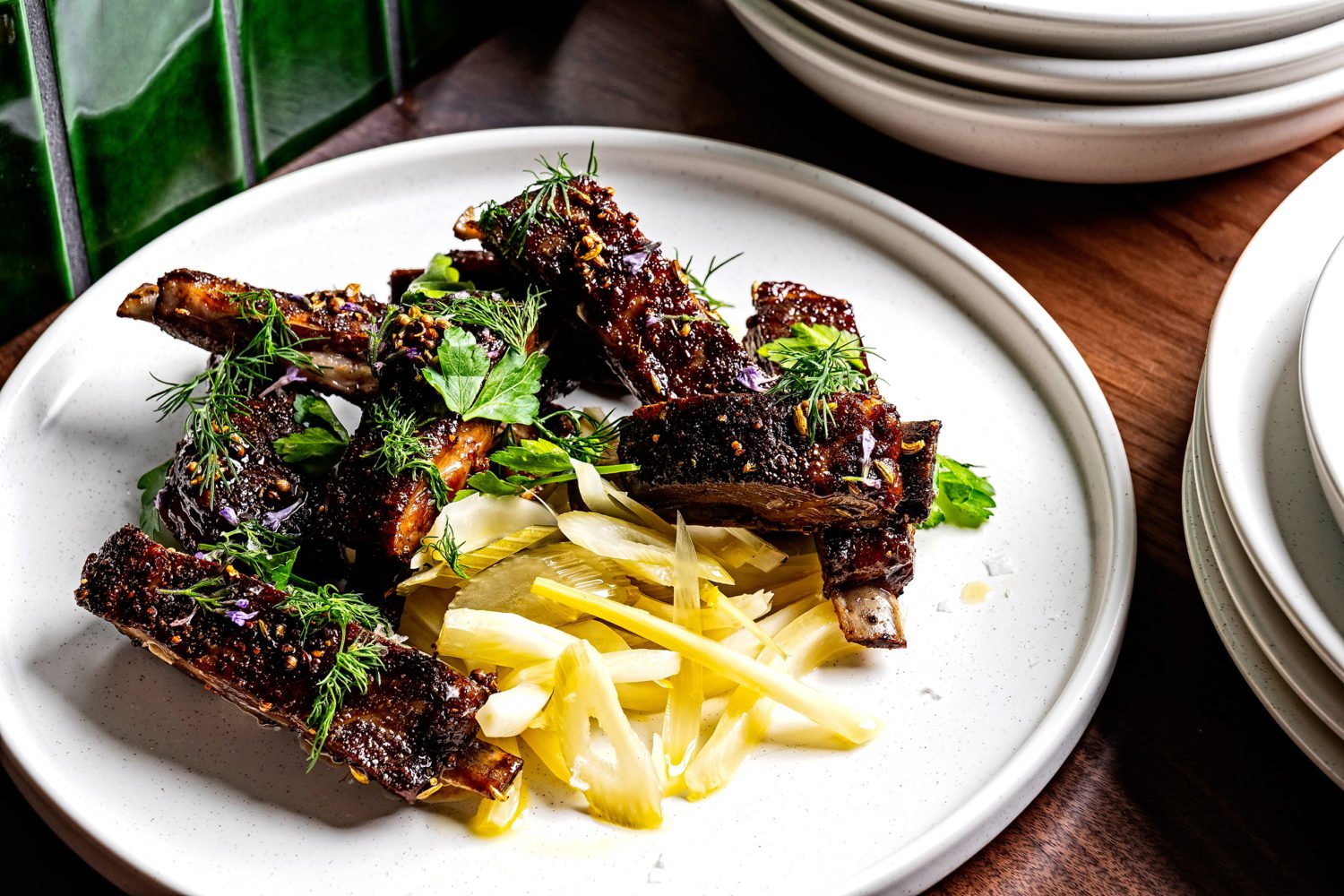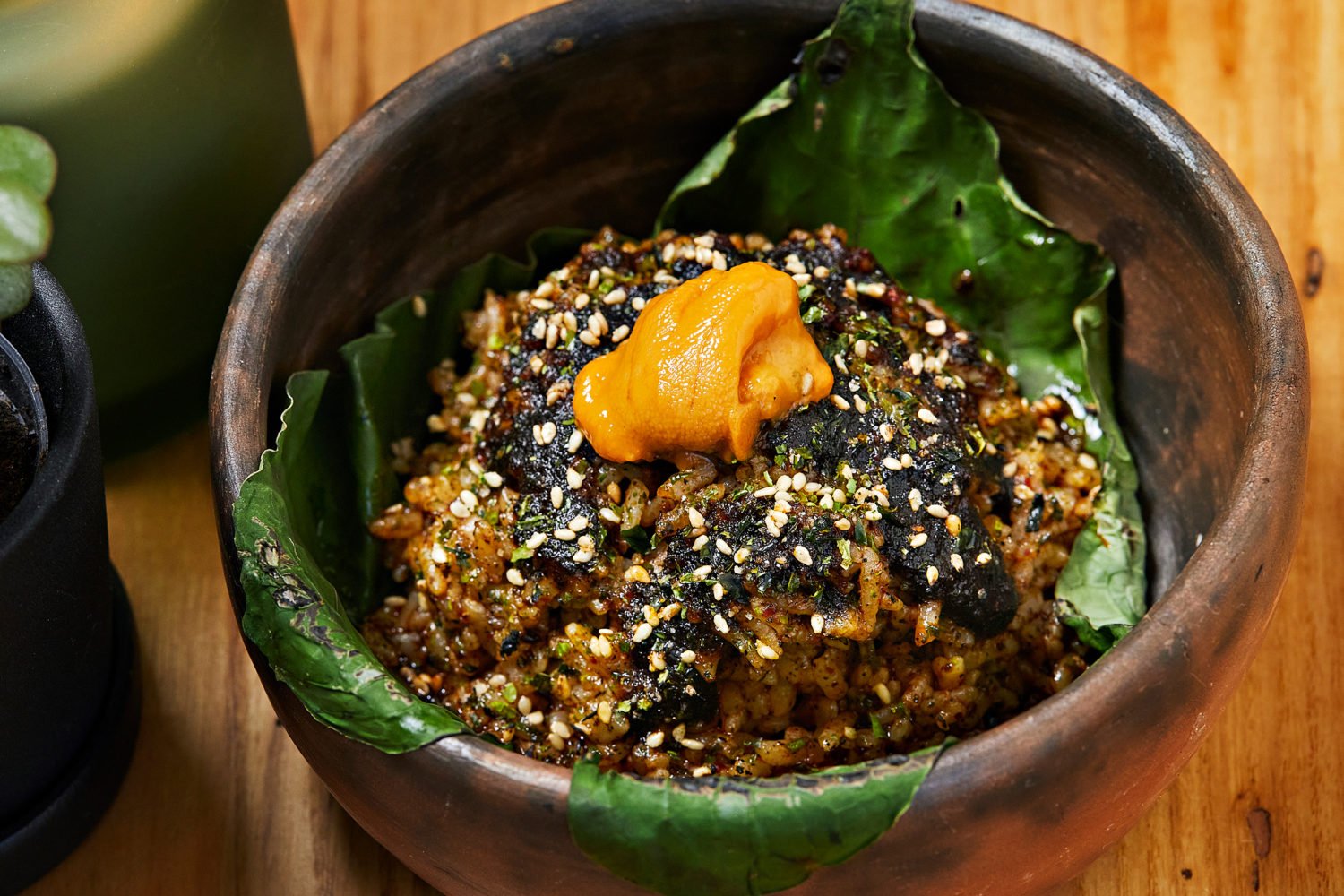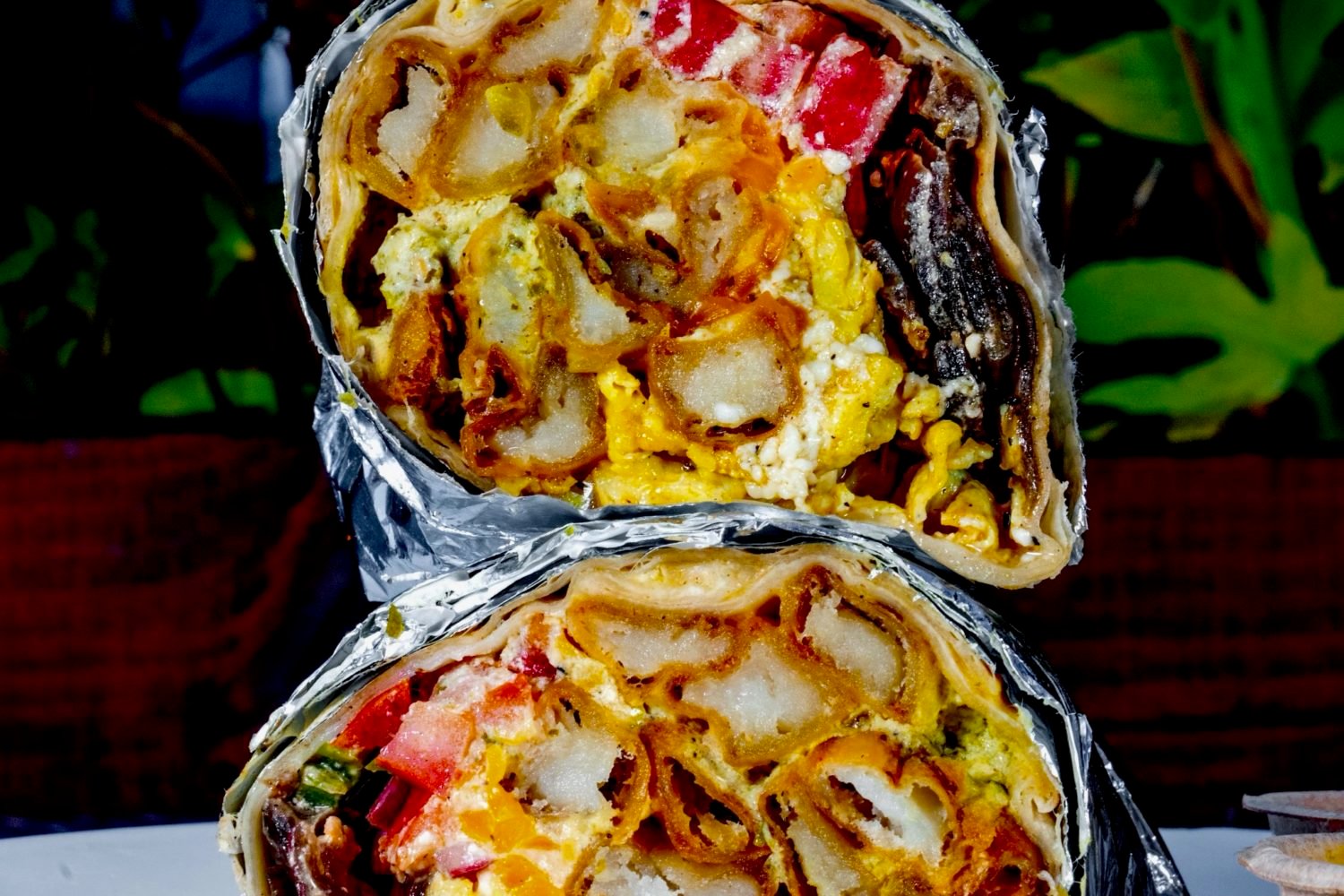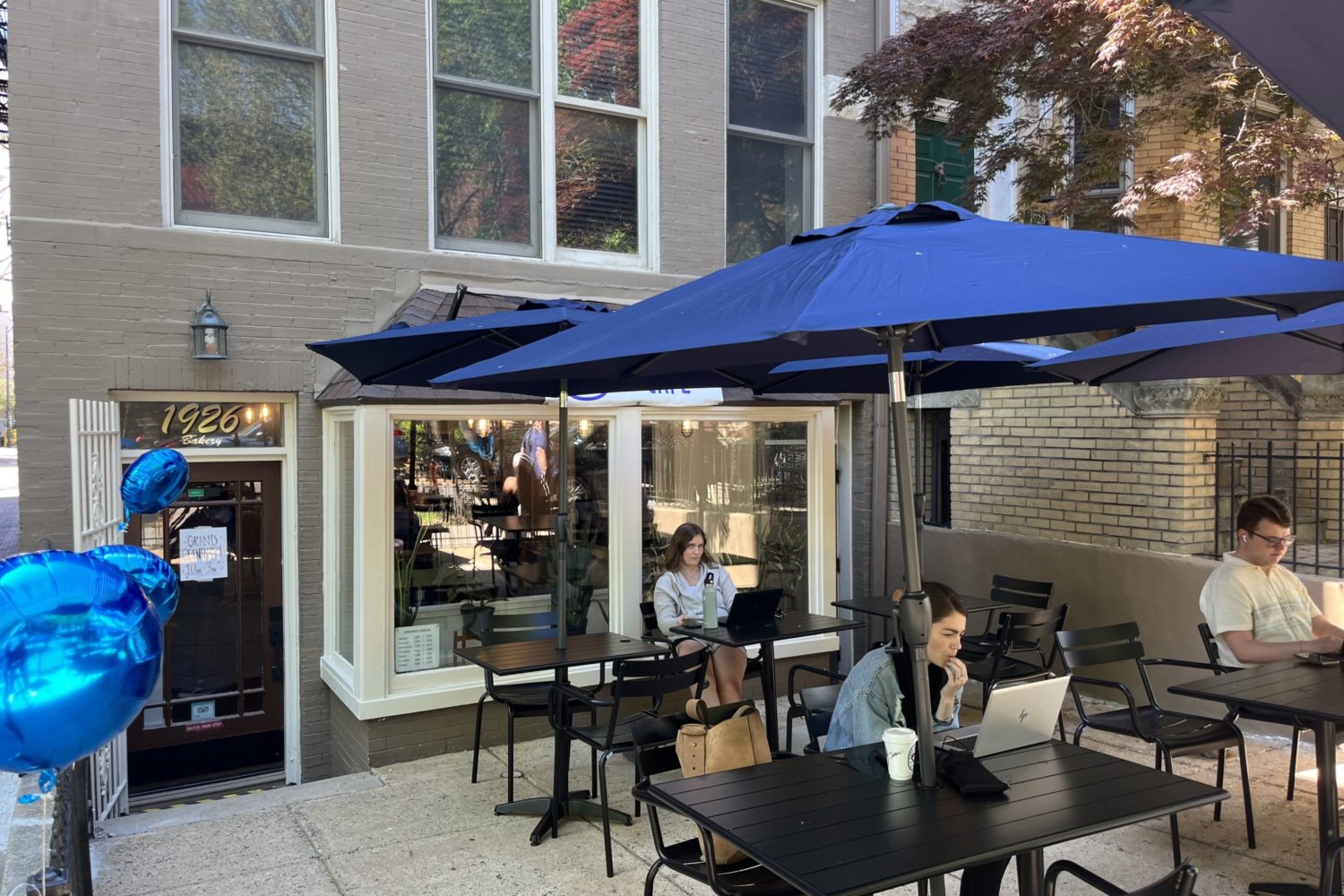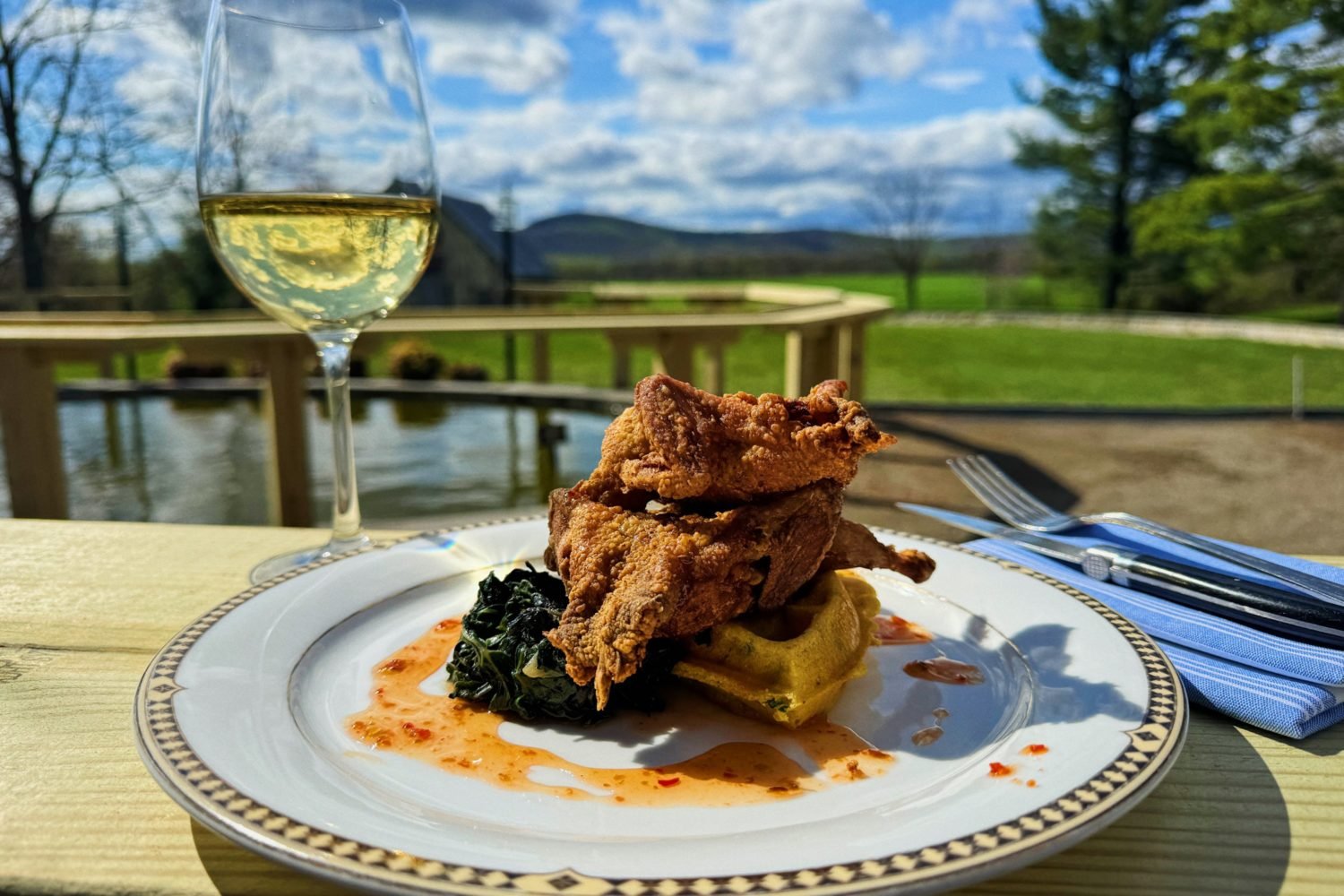From September 10, 2008
Alain Ducasse and his 14 Michelin stars blew into town last night for the opening of Adour at the St. Regis, and we were there.
Part one of our coverage began with food and wine editor Todd Kliman’s dispatches from the dining room—the first-ever real-time restaurant review.
Part two concludes today.
Below we give you not one critic’s appraisal of the restaurant but three—three scorecards (Adour cards, if you will). We follow that with an assessment of Adour’s wine program because the restaurant has billed its technique-driven French cooking as “designed with wine in mind.”
Four critics weighing in on things would seem as much an instance of overkill as following a multicourse meal with cheese and dessert and a tray of petits fours—not to mention a violation of the usual critical imperative to give a new place a few weeks to a month to settle in and work out the kinks.
Did we have misgivings about this? You bet we did. But throughout our many discussions, one thought overrode all the others: Why not?
Why not have a little fun? Why not devote all our critical resources to covering a high-profile debut with depth and wit?
Surely, we figured, if any restaurant ought to be able to handle this degree of opening-night scrutiny, it’s a rigorously drilled outpost of the vast Ducassian empire.
The scorecards, mind you, aren’t intended to be final judgments, merely a snapshot of a moment in time. And, not least, a little peek into our world as critics.
Finally, to complete the picture of opening night—a cubist picture, but a complete picture, we hope—we had new assistant editor Kate Nerenberg set up with a video camera inside the hotel, interviewing diners as they left Adour. You'll find that posted later today.
As the servers all say these days when setting down the feast before you: Enjoy.
Critic: Todd Kliman
Word that springs to mind when you walk through the door: Modish.
Quality of the welcome: Professional, gracious, broadly smiling—very much the sort of greeting that new, aiming-for-the-big-time restaurants tend to lavish on their customers in the first 90 days. (In the interest of full disclosure, I was ID’d almost immediately.)
Quality of table/level of comfort: We were directed to a table almost at the end of a banquette, where we’d have been flanked by other diners, so we asked to be put against the wall for more privacy. Better, more comfortable, more private.
The space: Slicker and more contemporary than I might have expected, but the old wooden beams from the hotel’s long-ago early years help to anchor the room, giving it a sturdiness and solidity. The three gold-backed alcoves, framed by more dark wood, and the clear-glassed wine racks lend the room the air of a wine cellar. As the night wore on and the lights dimmed, the room glowed, and the gold accents set off the handsome, dark wood of the floors and alcoves.
Who’s there/what they’re wearing: “Stylish casual,” says the Web site, but this is DC—very few men weren’t wearing jackets and ties (including Senator Tom Daschle, who commanded an eight-top in the center of the room), and very few women weren’t squeezed into cocktail dresses. The room, on this night, reeked of money, of easy privilege; a three-top near us ordered not one but two bottles of Dom Pérignon.
First impressions of the menu: Classical, technique-driven, and deeply conservative.
First course: Tender ricotta gnocchi; sauteed lettuce, crispy prosciutto, wild mushroom ($17, one of the cheaper appetizers on the menu). The gnocchi—described, twice, as pillowy by our server—were large and soft, almost the texture of poached egg; just enough flour in there to keep the ricotta from running. The other ingredients on the plate were fine individually, but the sum was less than its parts. An assembled dish rather than one that coheres and lingers in the mind long afterward.
The pressed foie gras and organic chicken ($26), the other appetizer, was presented in a precise, thick-cut slab (pressed chicken flanking a thick interior of foie gras). Rich but not over-the-top rich, it demonstrated great control and restraint—a dish of great balance. (And it went down beautifully with a Brundlmayer Riesling from Terry Theise; then again, you could probably pair a Theise wine with a Moon Pie.) The black-truffle emulsion: earthy, intense, sensual. A little swipe went a long way. Did I love it? Almost. But love is too, too strong a word in this case. And we are talking about an appetizer that costs more than an entrée in most restaurants.
Second course: Veal sweetbreads; green and white Swiss chard; veal jus ($36). There was a remarkable meatiness to the sweetbreads and an atypical succulence. The two chards were swapped for braised bok choy, which gave off a hint of something lemony. Alain Ducasse, said the sommelier, aims for no more than four elements on the plate, and the idea is to bring out the essence of the ingredients—bring out the essence and heighten the essence. The sweetbreads were a good example of this. I was also struck by the wonderful color of the dish—browns and tans and golds and light greens and dark greens. Vermeer’s palette. Few chefs pay much attention to color.
Also, a “classic” squab breast, with seared foie gras and salmis sauce ($39). The squab was gamey, in a good way, with a meaty, blood-borne quality I like in a game meat. Perfectly cooked and served atop pedestals of potato; the potatoes did little for the dish—what’s more, they soaked up a lot of the (earthy, offaly, deeply reduced) salmis sauce, becoming soggy. The foie gras was cooked past the point of inner pinkness (perhaps because it sat for an extended time under a heat lamp while I was “in the bathroom,” texting?)
Dessert/cheese: Gala-apple soufflé, Granny Smith compote, Calvados ladyfinger, vanilla ice cream. The soufflé was undercooked; the ice cream was stellar.
The oddly titled “rhubarb and strawberry, buttermilk panna cotta, Bostock brioche” brought us unexpectedly deep satisfactions. The Bostock brioche, with almond paste inside and slivered almonds outside, was a dream of a cookie, and I loved the addition of a strawberry granité—giving the dish a variety of tastes and textures: hard and soft, cool and creamy, bready and icy.
I’d been spotted and so was brought a third dessert: the baba au rhum. The baba was gorgeous, the bread sliced tableside, right down the middle, doused with Armagnac and topped with an intensely rich, intensely whipped cream. The signature finish of every Ducasse restaurant (so said our server), it already ranks as one of the best desserts in the city.
Best course: Dessert. The highlight of the meal—the moment that dinner achieved liftoff. And the macarons (chocolate and raspberry) that came with the desserts were superb—better, even, than the ones at the legendary Ladurée in Paris.
Degree of innovation: Modest. DC isn’t the conservative, cautious town it was a decade ago, and it’s suddenly crowded at the top: With Michel Richard’s boundary pushing, Johnny Monis’s heart-on-his-sleeve soulfulness, Frank Ruta’s masterly twinning of French and Italian, Eric Ziebold’s witty, global excursions, and José Andrés’s madcap but delicious science experiments, Adour must find a way to separate itself from the field—must find a niche. Ducasse’s protégé, Julien Jouhannaud, is going to have to push his crew to discover an identity.
Service/attentiveness: Super-attentive—overattentive, even. A function of the 90-day push, the three-month start-up period when big-time restaurants flood the dining room with extra hands and eyes. Our table was watched all night by a guy who stood sentinel across the room and, almost like a sniper, never took his eyes from our table.
Pacing: Hard to judge. I ducked out for short periods to take notes, no doubt throwing off the rhythm of the kitchen.
If only . . . : There had been more risk. I don’t expect a Ducasse restaurant to indulge in foams and airs and other bits of culinary science, but I do expect cooking that not only is technically precise but also challenges diners, forces them to see things anew. At these prices, and with this pedigree, it can’t be asking too much.
Blowout or expense account? At this point—and it’s as early as early gets—expense account.
How exquisite is it? Several things were: the gougères that were brought out while we scanned our menus, the tuna-tartare amuse, the sweetbreads, the desserts, the macarons. But on the whole, dinner was too uneven to be transcendent. B-.
——————————————————————————————————————
Critic: Cynthia Hacinli
Word that springs to mind when you walk through the door
Quality of the welcome: Solicitous but a bit dazed and confused. Waiters at the bar didn’t let us transfer our tab ($44 for two glasses of bubbly). Servers in dining room said they should have been able to do it.
Quality of table/level of comfort: Virtually no Siberia tables (the window spots and circular booths in the back are prime). Sink-into ecru leather chairs and textured-fabric banquettes (complete with movable armrests, a new one on me), which encourage leisurely meals and conversation. Pepper and salt grinders on each table are a nice touch.
The space: Midcentury modern by way of Metropolitan Home, with a very on-trend mix of old (ornate vintage ceiling beams) and new (glowing “anemone” sconces).
Who’s there/what they’re wearing: Politicos in suits, Washington blondes in cocktail dresses with cardigans tied over their shoulders, an elderly Frenchwoman dining alone, a pair of old-guard WASPs talking about Paris the way it “used to be.”
First impressions of the menu: You’ll need Google at the ready to translate culinary esoterica like “Bostock brioche,” an almond-flavored version of the eggy bread.
First course: Corn-cappuccino soup ($9), a foamy elixir of puréed corn ladled over a small pileup of buttery corn kernels, croutons, mushrooms, and crème fraîche. The essence of corn in liquid form. Delicious. Seared foie gras, date marmalade, preserved confit lemon, $27—a generous plate with two perfectly seared slabs. Swirls of marmalade and confit are a fine counterpoint to the salty foie. But it’s the soup I’ll remember and think about for weeks after. Freebies from the chef—gougères crusted with artisanal salt and pepper and a couple of bites’ worth of buttery tuna tartare—were pleasant, too.
Second course: Roasted Maine lobster with spinach and salsify, $44; we’re told two pounds’ worth, but what arrived in its briny coral sauce (besides roe, it’s made from the jus of pressed lobster heads) seems awfully puny for a two-pounder. It certainly satisfied, but we were thinking about taking a few morsels home. Still, it was far more interesting than the olive-oil-poached Gloucester cod ($25). The red-and-yellow piperade with it was wonderful (soft, almost melting), the fish curiously bland.
Dessert/cheese: A boozy baba doused with Armagnac and dollops of whipped cream, the signature dessert at all of Ducasse’s restaurants. It was good, but the Gianduja “sablé” with milk chocolate and candied orange should be considered for that honor. Layers of hazelnut, buttery cookie, creamy and hard chocolate, a play between bitter and sweet. Having been pushed aside in favor of dark chocolate in years past, milk chocolate seems to be making a comeback. Raspberry and chocolate macarons (the chocolate was fabulous!), which have more heft and chewiness than most, and delicately flavored chocolates, both gifts from the kitchen, are the sort of sweets you find at top Parisian chocolate/confection shops.
Best course: A tie between first and dessert. If really pressed, I’d have to say first, because of the soup.
Level of innovation: The kitchen aimed for subtle and assured rather than clever and flashy; Ducasse seems to be playing it safe, at least in the early days. The menu could use a jolt of fun.
Service/attentiveness: Servers were friendly, at the ready without being overly familiar, knowledgeable and helpful, although they were prone to pushing the most expensive wines by the glass. At one point, we were asked if we thought the restaurant was too stuffy; apparently, Ducasse is after a relaxed vibe. But not too relaxed. Sure enough, when my guest went to the powder room, her napkin was folded—albeit not immediately.
Pacing: French, which is to say leisurely. No one is going to grab your plate
If only . . . : The votives were real candles; at these prices, faux flickers seem a bit cheesy. And what’s with the sparkling rosé that’s room temperature?
Blowout or expense account? A place to be wined and dined—if someone else is paying, like your boss.
How exquisite is it? Some exquisite moments but overall a B.
——————————————————————————————————————-
Critic: Ann Limpert
Word that springs to mind when you walk through the door: Hidden. Everything in the lobby is clearly marked, except the restaurant, which is tucked behind the hotel’s bar.
Quality of the welcome: Not chilly, not warm—pretty much all business. Except that we arrived on time for our 8 PM reservation and were led straight to the bar, where we waited 20 minutes for a table in the dining room. Which was half full.
Quality of table/level of comfort: A table for two against the back wall. Comfortable enough, but the tables by the window or the cozy, crescent-shaped banquettes are the place to be.
The space: David Rockwell lite. The surprisingly small dining room lacks the sparkle and flash of many of the famed New York designer’s restaurants, but there are just enough mod touches (disco-ball-size glass orbs over each banquette; glossy, cream-toned tables) to keep it from feeling like a blah hotel spot.
Who’s there/what they’re wearing: A handful of smartly dressed young couples, a few solo suits with BlackBerries in reach on the table, but otherwise the crowd looked as if it had just been dismissed from a Capital One board meeting.
First impressions of the menu: Although the server stressed that we were having “Chef Julien’s cooking,” the menu was pretty similar to the menu of Ducasse’s New York branch of Adour.
First course: Pearly slabs of hamachi ($19) were meaty and delicious, their richness cut with cylinders of cucumber and twirled shavings of radish. Fabulous. But then a prettily arranged but ultimately bland composition of vegetables ($11)—beets, asparagus—reminded me of the done-to-death veggies certain spatula-challenged moms used to make. An odd appetizer that ate like a side. Meanwhile, I jealously eyed my neighbor’s double-size portion of foie gras.
Second course: Again, one hit, one miss. Sweet day-boat scallops ($37!) were swathed in a lush cauliflower purée and saved from over-richness by a lemony Grenobloise. A duck breast ($34), sliced in two, was of beautiful quality but salty and tough (I asked for medium rare). On the side, two slices of black olive and a runny polenta.
Dessert/cheese: Now we’re talking. All three ($12 each)—we couldn’t narrow it down—were fantastic. A Gala-apple soufflé was tender-topped with bits of caramelized apple in the pillowy batter (we ignored the ice-plagued vanilla ice cream that came with it). The chocolate sorbet—Adour’s signature dessert, according to the server—was a terrific interplay of textures, with shards of coffee granita, a magic-shell topping, and crumbles of caramelized brioche that tasted like the edges of the darkest, saltiest chocolate-chip cookie. And finally, my favorite, a raspberry custard with suprêmes of grapefruit and rose-blossom ice cream that looked plucked from one of the dessert spreads in Sofia Coppola’s Marie Antoinette. It came gilded with a sugared rose petal, and—no surprise—was perfect with demi-sec Champagne.
Best course: The welcome gougères, the desserts, and the gratis goodbye macarons (raspberry and Gianduja).
Level of innovation: With some dishes—the cucumber-marinated hamachi, the desserts—high. With others, not so much. Why so many culinary-school brown sauces?
Service/attentiveness: Ernest, knowledgeable, and friendly, if scattered.
Pacing: Seriously off. Forty-five minutes until we put in our order . . . an hour between appetizers and main courses.
If only . . . : We could have another round of gougères . . . and macarons.
Blowout or expense account? An expense-account lunch, for sure. But a splurge? Nope, not yet.
How exquisite is it? Our dinner was uniformly solid—there were no Bialystock-like flops—but with entrées in the $30-to-$40-plus range, I wanted to be wowed by more than dessert and kitchen freebies. B-.
——————————————————————————————————————–
Dave McIntyre’s Opening-Night Wine Report
Adour at the St. Regis boasts “cuisine designed with wine in mind.” The room design suggests wine as well, with obvious and subtle notes. Obvious are the two glass-enclosed, temperature-controlled wine vaults at either end of the dining room; they’re familiar from Charlie Palmer Steak and Central Michel Richard.
More subtle: The wall behind the hostess stand is covered with circular chrome mirrors that suggest the bubbles in a glass of Champagne; they reflect bottles from the red-wine vault just opposite. Along one wall, three semicircular alcoves are painted with flecked gold that from across the room resembles the slightly variegated texture of cork. More bubble mirrors above the round tables suggest the illusion of sitting inside a bottle of Champagne.
And Champagne is a noteworthy start to a meal at Adour. The Cuvée Alain Ducasse, a multivintage Brut assembled at the Lanson Champagne house by Gérard Margeon, wine director of the Ducasse empire. It’s rich, deep, and complex—and a splurge at $29 a glass. And it’s easy to sail into triple digits or higher when selecting a wine.
But the good news is that the list—assembled by sommelier Ramon Narvaez—doesn’t focus just on the high-end Burgundies and Bordeaux. Narvaez has peppered it with plenty of entries in the $30-to-$70 range, mostly from the smaller wine regions of France that present many of today’s best bargains. (About 60 percent of the list is French, 30 percent American, and the rest scattered from around the globe. Narvaez says he should have about 600-plus entries once the list is fully assembled.)
For our meal, we asked Narvaez to recommend wines for each of our courses. He scored big with his first recommendation, a Brundlmayer Riesling from Austria (a Terry Theise import) with the pressed-chicken-and-foie-gras terrine. Although the Riesling was dry—foie gras traditionally calls for a sweet wine—it matched perfectly with the cold chicken and especially the black-truffle emulsion.
We may have steered him toward the Domaine Haut-Plaisir 2005 Cahors (a Vintage 59 import), a personal favorite and a gem on the list at $30 a bottle. The bright blueberry fruit of the Malbec, balanced with a hint of earth but impressively elegant, danced well with the squab breast (and more foie gras) as well as the sautéed sweetbreads.
But a Neyers Chardonnay and a Byron Pinot Noir seemed flabby against both dishes, lacking the acid that would help cut the richness of the food.
Narvaez, familiar to DC diners from his time at Marcel’s, is clearly having fun at his new post. He presides over a decanting station near the kitchen, with various size vessels for Bordeaux or Burgundy, full bottle or half. He has a varied assortment of Spiegelau and Schott-Zwiesel stemware, with Riedel on the way. Your glass of wine is poured at the table, so you can inspect the label and change your mind after a taste if it’s not to your liking. And if the by-the-glass list doesn’t inspire you, Narvaez says he’ll open any bottle on the list for customers willing to pay the corresponding price for a glass.
Adour is the latest wine-themed restaurant to open in Washington. It comes with French flair and sophistication, and a dash of American informality. Most important, Ducasse and Narvaez recognize that Washington diners take their wine seriously and aren’t merely interested in throwing cash after exclusive labels. Narvaez is on the right track with a list that covers the menu at a variety of prices. Once the list is complete, it will reward further exploration.
Related:
Kliman Online Interview with Alain Ducasse
LIVE! from Adour at the St. Regis: The First-Ever Real-Time Restaurant Review
More>> Best Bites Blog | Food & Dining | Restaurant Finder






